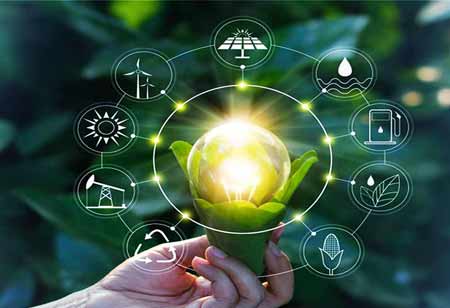Thank you for Subscribing to Energy Business Review Weekly Brief
Future-Proof Battery Technologies
A battery is a pack of one or more cells, each of which has a positive electrode (the cathode), a negative electrode (the anode), a separator, and an electrolyte.

By
Energy Business Review | Thursday, November 03, 2022
Stay ahead of the industry with exclusive feature stories on the top companies, expert insights and the latest news delivered straight to your inbox. Subscribe today.
Battery is a pack of one or more cells, each of which has a positive electrode (the cathode), a negative electrode (the anode), a separator, and an electrolyte.
Fremont, CA: A battery is a pack of one or more cells, each of which has a positive electrode (the cathode), a negative electrode (the anode), a separator, and an electrolyte. Different chemicals and materials for these impact the properties of the battery – how much energy it can save and output, how much power it can offer, or the number of times it can be discharged and recharged (also named cycling capacity).
Battery companies are constantly experimenting to find cheaper, denser, lighter, and more powerful chemistries. We spoke to Patrick Bernard - Saft Research Director, who explained three new battery technologies with transformative potential.
New-Generation Lithium-Ion Batteries
Lithium-ion (Li-ion) batteries provide energy storage and release by moving lithium ions from the positive to the negative electrode back and forth via the electrolyte. In this technology, the positive electrode acts as the initial lithium source, and the negative electrode as the host for lithium.
Several chemistries are gathered under the name of Li-ion batteries as the result of decades of selection and optimization close to perfection of positive and negative active materials. Lithiated metal oxides or phosphates are commonly used as positive material. Conversely, graphite, but also graphite/silicon, or lithiated titanium oxides are utilized as negative materials.
With actual materials and cell designs, li-ion technology is anticipated to reach an energy limit in the coming years. Nevertheless, recent discoveries of new families of disruptive active materials should unlock present limits.
These innovative compounds can save more lithium in positive and negative electrodes, allowing for the first time to combine energy and power. In addition, with these new compounds, the scarcity and criticality of
With state-of-the-art storage technologies, li-ion battery technology enables the highest energy density. In addition, performances such as fast charge or temperature operating windows (-50°C till 125°C) can be fine-tuned by the wide choice of cell design and chemistries.
Furthermore, Li-ion batteries display additional advantages such as low self-discharge and long lifetime cycling performances, typically thousands of charging/discharging cycles.
Lithium-Sulfur Batteries
In Li-ion batteries, the lithium ions are stored in active materials acting as stable host structures during charge and discharge. In lithium-sulfur (Li-S) batteries, there are no host structures. Instead, the lithium anode is consumed while discharging, and sulfur is transformed into various chemical compounds; the reverse process occurs during charging.
Advantages:
A Li-S battery uses very light active materials: sulfur in the positive electrode and metallic lithium as the negative electrode. As a result, its theoretical energy density is extraordinarily high: four times greater than lithium-ion. That makes it a good fit for the aviation and space industries.
Saft has selected and favored the most promising Li-S technology based on solid-state electrolytes. This technical path brings very high energy density and long life and overcomes the main drawbacks of the liquid-based Li-S (limited life, high self-discharge).
Furthermore, this technology is supplementary to solid-state lithium-ion thanks to its superior gravimetric energy density (+30% at stake in Wh/kg).
Solid State Batteries
Solid-state batteries represent a paradigm shift in terms of technology. In modern li-ion batteries, ions move from one electrode to another across the liquid electrolyte (also called ionic conductivity). In all-solid-state batteries, the liquid electrolyte is replaced by a solid compound that allows lithium ions to migrate.
This concept is far from new, but thanks to intensive worldwide research over the past ten years, new families of solid electrolytes have been discovered with very high ionic conductivity, similar to the liquid electrolyte, allowing this particular technological barrier to be overcome.
Advantages:
The first huge advantage is a marked improvement in safety at cell and battery levels: solid electrolytes are non-flammable when heated, unlike their liquid counterparts. Second, it permits using innovative, high-voltage high-capacity materials, enabling denser, lighter batteries with better shelf-life due to reduced self-discharge. Moreover, at the system level, it will bring additional advantages such as simplified mechanics and thermal and safety management.
As the batteries can exhibit a high power-to-weight ratio, they may be ideal for use in electric vehicles.






